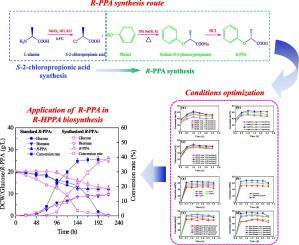当前位置:
X-MOL 学术
›
Chinese Journal of Chemical Engineering
›
论文详情
Our official English website, www.x-mol.net, welcomes your feedback! (Note: you will need to create a separate account there.)
An efficient route towards R-2-phenoxypropionic acid synthesis for biotransformative production of R-2-(4-hydroxyphenoxy)propionic acid
Chinese Journal of Chemical Engineering Pub Date : 2020-06-01 , DOI: 10.1016/j.cjche.2020.06.013 Haiyan Zhou , Yizuo Li , Rui Jiang , Xianlin Wang , Yuanshan Wang , Yaping Xue , Yuguo Zheng
Chinese Journal of Chemical Engineering Pub Date : 2020-06-01 , DOI: 10.1016/j.cjche.2020.06.013 Haiyan Zhou , Yizuo Li , Rui Jiang , Xianlin Wang , Yuanshan Wang , Yaping Xue , Yuguo Zheng

|
Abstract R-2-(4-hydroxyphenoxy)propionic acid (R-HPPA) is a key intermediate for the synthesis of classic herbicides with high selectivity against grassy weed. The main route for R-HPPA biosynthesis is to hydroxylate the substrate R-2-phenoxypropionic acid (R-PPA) at C-4 position with microbes. In order to provide sufficient R-PPA for the industrial production of R-HPPA, an effective R-PPA synthesis method was established and optimized in this work. The synthesis process mainly consisted of two steps: (1) synthesis of S-2-chloropropionic acid from L-alanine via diazotization and chlorination reactions; and (2) synthesis of R-PPA from S-2-chloropropionic acid and phenol via etherification reaction. The optimal reaction conditions were as follows: HCl: NaNO2: KI: L-Ala = 2.0: 1.2: 0.7: 1.0 (in molar), 125 °C reflux for 1.5 h, with KI as catalyst, and KI: S-2-chloropropionic acid: phenol = 0.075: 1.2: 1.0 (in molar). Under these conditions, an improved molar conversion rate (74.9%, calculated in phenol) was achieved. After extraction using anionic exchange resin Amberlite IRA-400 (CI), R-PPA product with a purity of 95.08% was obtained. The purified R-PPA was identified and evaluated in the application of the biotransformative production of R-HPPA. The results indicated that the synthesized R-PPA supported the R-HPPA biosynthesis with a comparable yield as that of the standard R-PPA. The R-PPA synthesis method provided herein exhibited the advantages of low price and easy availability of raw materials, less toxicity of reagents, simple manipulations, and low equipment/instrument requirements.
中文翻译:

用于生物转化生产 R-2-(4-羟基苯氧基)丙酸的 R-2-苯氧基丙酸合成的有效途径
摘要 R-2-(4-羟基苯氧基)丙酸(R-HPPA)是合成对禾本科杂草具有高选择性的经典除草剂的关键中间体。R-HPPA 生物合成的主要途径是用微生物在 C-4 位将底物 R-2-苯氧基丙酸 (R-PPA) 羟基化。为了为R-HPPA的工业化生产提供充足的R-PPA,本工作建立并优化了一种有效的R-PPA合成方法。合成过程主要包括两个步骤:(1)L-丙氨酸通过重氮化和氯化反应合成S-2-氯丙酸;(2)S-2-氯丙酸与苯酚醚化反应合成R-PPA。最佳反应条件为:HCl:NaNO2:KI:L-Ala=2.0:1.2:0.7:1.0(摩尔),125℃回流1.5h,以KI为催化剂,和KI:S-2-氯丙酸:苯酚=0.075:1.2:1.0(摩尔)。在这些条件下,实现了更高的摩尔转化率(74.9%,以苯酚计)。使用阴离子交换树脂Amberlite IRA-400 (CI)萃取后,得到纯度为95.08%的R-PPA产物。纯化的 R-PPA 在 R-HPPA 的生物转化生产中的应用中得到鉴定和评价。结果表明,合成的 R-PPA 支持 R-HPPA 生物合成,其产率与标准 R-PPA 的产率相当。本发明提供的R-PPA合成方法具有原料价格低廉易得、试剂毒性小、操作简单、设备/仪器要求低等优点。实现了更高的摩尔转化率(74.9%,以苯酚计)。使用阴离子交换树脂Amberlite IRA-400 (CI)萃取后,得到纯度为95.08%的R-PPA产物。纯化的 R-PPA 在 R-HPPA 的生物转化生产中的应用中得到鉴定和评价。结果表明,合成的 R-PPA 支持 R-HPPA 生物合成,其产率与标准 R-PPA 的产率相当。本发明提供的R-PPA合成方法具有原料价格低廉易得、试剂毒性小、操作简单、设备/仪器要求低等优点。实现了更高的摩尔转化率(74.9%,以苯酚计)。使用阴离子交换树脂Amberlite IRA-400 (CI)萃取后,得到纯度为95.08%的R-PPA产物。纯化的 R-PPA 在 R-HPPA 的生物转化生产中的应用中得到鉴定和评价。结果表明,合成的 R-PPA 支持 R-HPPA 生物合成,其产率与标准 R-PPA 的产率相当。本发明提供的R-PPA合成方法具有原料价格低廉易得、试剂毒性小、操作简单、设备/仪器要求低等优点。纯化的 R-PPA 在 R-HPPA 的生物转化生产中的应用中得到鉴定和评价。结果表明,合成的 R-PPA 支持 R-HPPA 生物合成,其产率与标准 R-PPA 的产率相当。本发明提供的R-PPA合成方法具有原料价格低廉易得、试剂毒性小、操作简单、设备/仪器要求低等优点。纯化的 R-PPA 在 R-HPPA 的生物转化生产中的应用中得到鉴定和评价。结果表明,合成的 R-PPA 支持 R-HPPA 生物合成,其产率与标准 R-PPA 的产率相当。本发明提供的R-PPA合成方法具有原料价格低廉易得、试剂毒性小、操作简单、设备/仪器要求低等优点。
更新日期:2020-06-01
中文翻译:

用于生物转化生产 R-2-(4-羟基苯氧基)丙酸的 R-2-苯氧基丙酸合成的有效途径
摘要 R-2-(4-羟基苯氧基)丙酸(R-HPPA)是合成对禾本科杂草具有高选择性的经典除草剂的关键中间体。R-HPPA 生物合成的主要途径是用微生物在 C-4 位将底物 R-2-苯氧基丙酸 (R-PPA) 羟基化。为了为R-HPPA的工业化生产提供充足的R-PPA,本工作建立并优化了一种有效的R-PPA合成方法。合成过程主要包括两个步骤:(1)L-丙氨酸通过重氮化和氯化反应合成S-2-氯丙酸;(2)S-2-氯丙酸与苯酚醚化反应合成R-PPA。最佳反应条件为:HCl:NaNO2:KI:L-Ala=2.0:1.2:0.7:1.0(摩尔),125℃回流1.5h,以KI为催化剂,和KI:S-2-氯丙酸:苯酚=0.075:1.2:1.0(摩尔)。在这些条件下,实现了更高的摩尔转化率(74.9%,以苯酚计)。使用阴离子交换树脂Amberlite IRA-400 (CI)萃取后,得到纯度为95.08%的R-PPA产物。纯化的 R-PPA 在 R-HPPA 的生物转化生产中的应用中得到鉴定和评价。结果表明,合成的 R-PPA 支持 R-HPPA 生物合成,其产率与标准 R-PPA 的产率相当。本发明提供的R-PPA合成方法具有原料价格低廉易得、试剂毒性小、操作简单、设备/仪器要求低等优点。实现了更高的摩尔转化率(74.9%,以苯酚计)。使用阴离子交换树脂Amberlite IRA-400 (CI)萃取后,得到纯度为95.08%的R-PPA产物。纯化的 R-PPA 在 R-HPPA 的生物转化生产中的应用中得到鉴定和评价。结果表明,合成的 R-PPA 支持 R-HPPA 生物合成,其产率与标准 R-PPA 的产率相当。本发明提供的R-PPA合成方法具有原料价格低廉易得、试剂毒性小、操作简单、设备/仪器要求低等优点。实现了更高的摩尔转化率(74.9%,以苯酚计)。使用阴离子交换树脂Amberlite IRA-400 (CI)萃取后,得到纯度为95.08%的R-PPA产物。纯化的 R-PPA 在 R-HPPA 的生物转化生产中的应用中得到鉴定和评价。结果表明,合成的 R-PPA 支持 R-HPPA 生物合成,其产率与标准 R-PPA 的产率相当。本发明提供的R-PPA合成方法具有原料价格低廉易得、试剂毒性小、操作简单、设备/仪器要求低等优点。纯化的 R-PPA 在 R-HPPA 的生物转化生产中的应用中得到鉴定和评价。结果表明,合成的 R-PPA 支持 R-HPPA 生物合成,其产率与标准 R-PPA 的产率相当。本发明提供的R-PPA合成方法具有原料价格低廉易得、试剂毒性小、操作简单、设备/仪器要求低等优点。纯化的 R-PPA 在 R-HPPA 的生物转化生产中的应用中得到鉴定和评价。结果表明,合成的 R-PPA 支持 R-HPPA 生物合成,其产率与标准 R-PPA 的产率相当。本发明提供的R-PPA合成方法具有原料价格低廉易得、试剂毒性小、操作简单、设备/仪器要求低等优点。









































 京公网安备 11010802027423号
京公网安备 11010802027423号